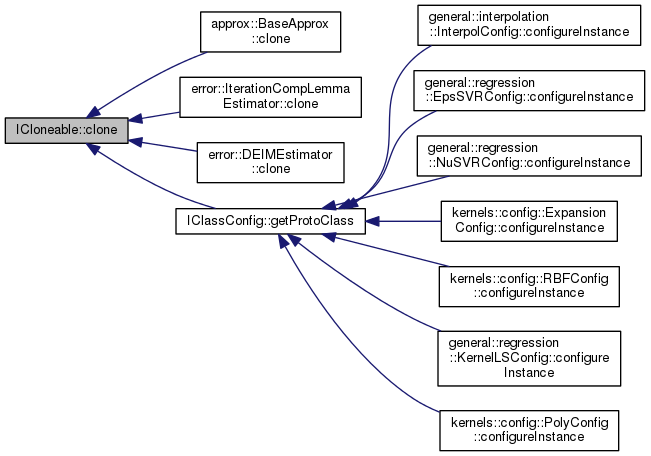 |
KerMor
0.9
Model order reduction for nonlinear dynamical systems and nonlinear approximation
|
 |
KerMor
0.9
Model order reduction for nonlinear dynamical systems and nonlinear approximation
|
ICLONEABLE Interface for cloneable handle classes. More...
ICLONEABLE Interface for cloneable handle classes.
Any implementing class should optionally take the "target" argument as an subclass instance of the current class. This is to enable superclasses to fill in private variables needed for correct functionality of the cloned object. Example: Superclass "A" has a private property "d", and subclass "B" is calling A.clone(<new B instance> new) so that class "A" can set new.d = this.d.
Definition at line 17 of file ICloneable.m.
Public Member Functions | |
| virtual function copy = | clone (target) |
| The interface method with returns a copy of the current class instance. More... | |
Additional Inherited Members | |
 Public Attributes inherited from handle Public Attributes inherited from handle | |
| addlistener | |
| Creates a listener for the specified event and assigns a callback function to execute when the event occurs. More... | |
| notify | |
| Broadcast a notice that a specific event is occurring on a specified handle object or array of handle objects. More... | |
| delete | |
| Handle object destructor method that is called when the object's lifecycle ends. More... | |
| disp | |
| Handle object disp method which is called by the display method. See the MATLAB disp function. More... | |
| display | |
| Handle object display method called when MATLAB software interprets an expression returning a handle object that is not terminated by a semicolon. See the MATLAB display function. More... | |
| findobj | |
| Finds objects matching the specified conditions from the input array of handle objects. More... | |
| findprop | |
| Returns a meta.property objects associated with the specified property name. More... | |
| fields | |
| Returns a cell array of string containing the names of public properties. More... | |
| fieldnames | |
| Returns a cell array of string containing the names of public properties. See the MATLAB fieldnames function. More... | |
| isvalid | |
| Returns a logical array in which elements are true if the corresponding elements in the input array are valid handles. This method is Sealed so you cannot override it in a handle subclass. More... | |
| eq | |
| Relational functions example. See details for more information. More... | |
| transpose | |
| Transposes the elements of the handle object array. More... | |
| permute | |
| Rearranges the dimensions of the handle object array. See the MATLAB permute function. More... | |
| reshape | |
| hanges the dimensions of the handle object array to the specified dimensions. See the MATLAB reshape function. More... | |
| sort | |
| ort the handle objects in any array in ascending or descending order. More... | |
|
pure virtual |
The interface method with returns a copy of the current class instance.
| target | If clone was called for a subclass of this class, target must contain the new instance of the subclass that is to be the cloned result. |
Implemented in kernels.KernelExpansion, dscomponents.ACoreFun, dscomponents.ACompEvalCoreFun, general.DEIM, kernels.ParamTimeKernelExpansion, error.BaseEstimator, approx.algorithms.ABase, error.BaseCompLemmaEstimator, general.AffParamMatrix, kernels.BaseKernel, dscomponents.ParamTimeKernelCoreFun, kernels.BellFunction, approx.algorithms.AAdaptiveBase, general.regression.BaseScalarSVR, models.pcdi.BaseCoreFun, models.pcd.BaseCoreFun, general.AProjectable, IClassConfig, kernels.ARBFKernel, kernels.config.RBFConfig, kernels.config.ExpansionConfig, approx.BaseApprox, dscomponents.AMassMatrix, dscomponents.AOutputConv, general.regression.BaseQPSVR, and IKernelCoeffComp.
Referenced by approx.BaseApprox.clone(), error.IterationCompLemmaEstimator.clone(), error.DEIMEstimator.clone(), and IClassConfig.getProtoClass().
